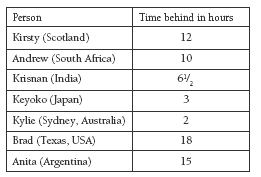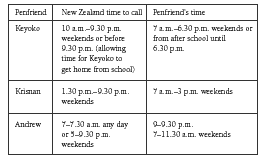Dialling Dilemma
This is a level 3 algebra strand activity from the Figure It Out series.
A PDF of the student activity is included.
Click on the image to enlarge it. Click again to close. Download PDF (892 KB)
apply a rule
interpret timezones information
FIO, Level 3-4, Algebra, Dialling Dilemma, page 18
classmate
In this activity, the students apply rules in a practical situation. Have an analogue clock available for them to use to count the hours. It is easiest to do the problem without taking daylight saving into account. (As an extension, you could ask the students to do the problem again, this time with daylight saving. If New Zealand is in daylight saving time, our clocks are put forward by one hour. This means other countries are another hour behind us, assuming that they are not also on daylight
saving.)
In non-daylight saving time, the differences are:
Hirani wants to phone Kirsty at 7 p.m. (or 1900 on a 24 hour clock) Scotland time. Scotland is 12 hours behind New Zealand, so Hirani will have to add 12 hours on to 7 p.m. to find the time in New Zealand. 12 hours on from 7 p.m. is 7 a.m., so Hirani will phone Kirsty at 7 a.m. New Zealand time. Using a 24 hour clock, you could calculate this as 1900 + 1200 = 3100, which is 700.
Brad in Texas is 18 hours behind New Zealand, so Hirani will have to add 18 hours on to 7 p.m. 18 hours on from 7 p.m. is 1 p.m. (1900 + 1800 = 3700, which is 1300) the next day. That is, 7 p.m. for Brad on a Saturday will be 1 p.m. on Sunday for Hirani.
Hirani’s bedtime means that she cannot call Keyoko, Krisnan, and Andrew at 7 p.m. their time. The students could work out what time in each country Hirani is awake. This time, the students will have to subtract the time difference because they are going from New Zealand time to another country’s time.
For Krisnan, Hirani will be awake from:
7 a.m. New Zealand time: subtract 61/2 hours to get 12.30 a.m. Indian time
9.30 p.m. New Zealand time: subtract 61/2 hours to get 3 p.m. Indian time.
But 12.30 a.m. is the middle of the night, so Hirani can’t phone Krisnan then. Supposing Krisnan gets up at 7 a.m., Hirani could phone him from 7 a.m. to 3 p.m. Indian time. This is from 1.30 p.m. to 9.30 p.m. New Zealand time.
The time differences between countries are due to the rotation of the Earth as it orbits the Sun. You can demonstrate this using an overhead projector and a globe of the Earth (or ball). Consider the position of each country and what time of day it will be as the globe rotates. For example, at 12 midday, the countries in longitude line with New Zealand are facing directly towards the sun. On the other side of the Earth (for example, the UK), it is midnight because they are facing directly away from the sun. The Earth rotates anticlockwise, so the dawning of a new day can be seen as the light enters countries, and the dusk in other countries can be seen as they lose the light.
Answers to Activity
1. a. Kirsty: 7 a.m.
Keyoko: 10 p.m.
Kylie: 9 p.m.
Brad: 1 p.m.
Krisnan: 1.30 a.m.
Andrew: 5 a.m.
Anita: 10 a.m.
b. Suggestions could include:
Hirani can keep to her 7 p.m. plan by ringing Kirsty as soon as she gets up
(7 p.m. Kirsty’s time), Brad at 1 p.m. in the weekends (7 p.m. Brad’s time), and
Anita at 10 a.m. in the weekends (7 p.m. Anita’s time).
2. Find the International Country and Area Codes section of the telephone book, find the country you want (they are listed alphabetically), and look under the column that says Hours behind NZ. Work backwards from the time showing
on your watch.
3. The time is different in other countries so that the time of day matches when the sun rises in each country. (The planet Earth rotates, so different parts of the earth are facing the sun at different times.)


